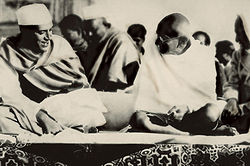

The first step toward Indian independence and western-style democracy was taken with the appointment of Indian councilors to advise the British viceroy, and with the establishment of provincial Councils with Indian members; the councillors' participation was subsequently widened in legislative councils. From 1920 leaders such as Mohandas Karamchand Gandhi began highly popular mass movements to campaign against the British Raj, using largely peaceful methods. Some other revolutionaries adopted militant approach; revolutionary activities against the British rule took place throughout the Indian sub-continent. The profound impact Gandhi had on India and his ability to gain independence through a totally non-violent mass movement made him one of the most remarkable leaders the world has ever known. He led by example, wearing a minimum of homespun clothes to weaken the British textile industry and orchestrating a march to the sea, where demonstrators proceeded to make their own salt in protest against the British monopoly. Indians gave him the name Mahatma, or Great Soul, first suggested by the Bengali poet Rabindranath Tagore. Subash Chandra Bose, a great freedom fighter, had organised a formidable army to fight against the British rule. Bhagat Singh was another Indian freedom fighter, considered to be one of the most influential revolutionaries of the Indian independence movement; he is often referred to as Shaheed Bhagat Singh (the word shaheed means "martyr"). Veerapandiya Kattabomman was also another freedom fighter who started his freedom movement against British rule by refusing to pay tax to British Government. These movements succeeded in bringing Independence to the Indian sub-continent in 1947. One year later, Gandhi was assassinated. However, he did live long enough to free his homeland and thus recognised as father of nation.

No comments:
Post a Comment